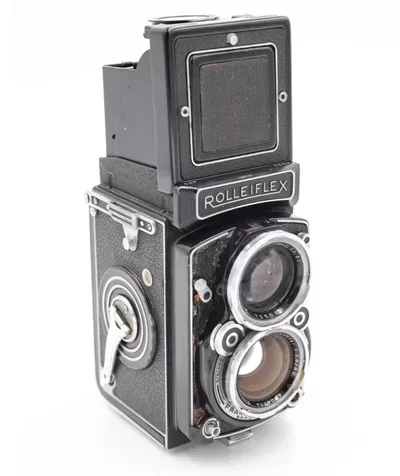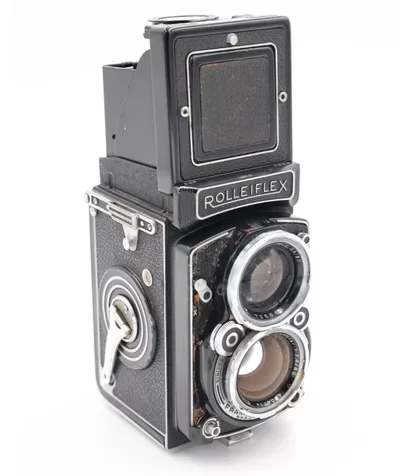The Rolleiflex is a brand of medium-format twin-lens reflex (TLR) cameras that have been popular among photographers for many decades. These cameras are known for their high-quality optics, precision engineering, and distinctive design.
Key features of Rolleiflex cameras typically include:
Twin-Lens Reflex System: The Rolleiflex cameras have two lenses stacked on top of each other. The top lens is used for composing the image, while the bottom lens exposes the film. This TLR system allows for accurate framing and focusing.
120 Film Format: Most Rolleiflex cameras use 120 film, which produces larger negatives than 35mm film, resulting in higher image quality and detail.
Square Format: The majority of Rolleiflex cameras produce square images, which has a unique and artistic appeal.
High-Quality Optics: Rolleiflex cameras are known for their exceptional lenses, which deliver sharpness and clarity in images. The lenses are often made by reputable manufacturers like Carl Zeiss.
Manual Controls: Rolleiflex cameras typically offer full manual control over exposure settings, including aperture, shutter speed, and focus.
Mechanical Reliability: These cameras are known for their robust build quality and mechanical reliability, often lasting for many years with proper care.
Rolleiflex cameras have been used by professional photographers, amateurs, and artists for various types of photography, including portrait, landscape, street, and documentary photography. They have a rich history and are often associated with a sense of classic photography. While the popularity of film photography has waned with the rise of digital photography, Rolleiflex cameras remain highly regarded and sought after by collectors and enthusiasts.
See the film cameras listed on eBay


Rolleiflex TLR
The term “Rolleiflex TLR” refers to a specific line of twin-lens reflex (TLR) cameras produced by the German camera manufacturer Rollei (Franke & Heidecke). These cameras are highly regarded for their quality optics, precision engineering, and iconic design. “TLR” stands for “twin-lens reflex,” which is a type of camera that has two lenses stacked on top of each other:
Viewing Lens: The top lens is used for composing the image. It’s the one you look through when framing your shot.
Taking Lens: The bottom lens is the one that actually takes the photograph, exposing the film.
The Rolleiflex TLR cameras were known for their square format images and used 120 roll film. Here are some key characteristics and features of Rolleiflex TLR cameras:
Square Format: These cameras typically produce square (6×6 cm) images, which have a unique and artistic appeal.
High-Quality Optics: Rolleiflex TLR cameras are renowned for their exceptional lenses, often manufactured by reputable companies like Carl Zeiss or Schneider Kreuznach. These lenses delivered sharpness and clarity in images.
Mechanical Precision: Rolleiflex cameras were known for their precise mechanical engineering and durability. They featured reliable shutters and mechanisms, making them long-lasting cameras.
Manual Controls: These cameras offered full manual control over exposure settings, including aperture, shutter speed, and focus. This manual control allowed photographers to have a high degree of creative control over their shots.
Twin-Lens Reflex Design: The TLR design allowed for accurate framing and focusing, making it popular among professional photographers and serious amateurs.
Iconic Design: Rolleiflex cameras are known for their distinctive and elegant design. They have a recognizable appearance, with the two lenses and a viewing hood on top of the camera.
Rolleiflex TLR cameras have a rich history and were widely used in various forms of photography, including portrait, landscape, street, and documentary photography. While digital photography has largely replaced film photography in the mainstream, Rolleiflex TLR cameras remain highly sought after by collectors and enthusiasts for their historical significance and timeless design.
See the film cameras listed on eBay
Famous photographers who used Rolleiflex TLR
The Rolleiflex TLR cameras have been favored by numerous famous photographers and artists over the years for their exceptional optics, mechanical reliability, and distinctive image quality. Here are some well-known photographers who used Rolleiflex TLR cameras:
Diane Arbus: The American photographer Diane Arbus used a Rolleiflex camera extensively for her documentary and portrait photography. Her work often featured marginalized or unconventional subjects.
Vivian Maier: Vivian Maier, an American street photographer, is known for her candid and often poignant photographs of everyday life. She used a Rolleiflex camera during her prolific but mostly unknown career as a photographer.
Robert Doisneau: The French photographer Robert Doisneau, famous for his iconic image “The Kiss by the Hôtel de Ville,” used a Rolleiflex camera for much of his street photography in Paris.
Irving Penn: The renowned American portrait and fashion photographer Irving Penn used a Rolleiflex TLR camera in the earlier part of his career before transitioning to larger format cameras. His early work often featured close-up portraits.
Richard Avedon: Another influential American fashion and portrait photographer, Richard Avedon, used a Rolleiflex camera for some of his earlier work.
Yousuf Karsh: The Armenian-Canadian portrait photographer Yousuf Karsh, famous for his striking portraits of notable individuals, including Winston Churchill and Albert Einstein, used a Rolleiflex camera in his early career.
Lisette Model: Lisette Model, an Austrian-born American photographer known for her street photography and portraits, used a Rolleiflex camera for many of her images.
Jacques-Henri Lartigue: The French photographer Jacques-Henri Lartigue, known for his candid and joyful images capturing the Belle Époque era and beyond, also used a Rolleiflex TLR camera.
These photographers are just a few examples of the many artists who appreciated the qualities of Rolleiflex TLR cameras for their work. The cameras’ square format and mechanical reliability made them popular choices for a wide range of photographic styles and subjects.
See the film cameras listed on eBay
Buyers guide for the Rolleiflex TLR
If you’re considering buying a Rolleiflex TLR camera, whether as a collector’s item or for actual use in photography, it’s important to follow a buyer’s guide to ensure you make an informed and satisfying purchase. Here are some essential steps and considerations:
Research and Familiarize Yourself:
- Learn about the different models and variations of Rolleiflex TLR cameras, as there were numerous models produced over the years.
- Familiarize yourself with their features, specifications, and any specific characteristics of interest.
Set a Budget:
- Determine your budget for purchasing a Rolleiflex TLR. Prices can vary significantly based on the model, condition, and rarity of the camera.
Decide on Your Purpose:
- Consider whether you intend to use the camera for photography or as a collector’s item. Your intended use may influence the type and condition of the camera you seek.
Condition Matters:
- Check the condition of the camera, including the lenses, shutter, film transport mechanism, and cosmetic appearance.
- Ask the seller about any known issues, repairs, or maintenance that has been performed on the camera.
- Look for signs of wear and tear, such as scratches, dents, or brassing.
Check the Lenses:
- Examine the lenses for scratches, fungus, haze, or separation. Clean optics are crucial for image quality.
- Ask for sample images taken with the camera if possible to assess the lens quality.
Shutter and Mechanics:
- Test the shutter at different speeds to ensure it works accurately and consistently.
- Verify that the film transport mechanism is functioning smoothly and that the camera advances the film properly.
Accessories and Extras:
- Determine what accessories are included with the camera, such as lens caps, filters, hoods, and cases. These items can add value.
- Consider the availability of replacement parts and accessories for the specific model you’re interested in.
Ask About the History:
- Inquire about the camera’s history, including the number of previous owners and how it has been stored and maintained.
Buy from Reputable Sellers:
- When purchasing from private sellers or online marketplaces, check the seller’s reputation and reviews.
- If buying from a camera store or dealer, inquire about any warranty or return policy.
Test It Yourself:
- If possible, handle the camera in person before making a purchase. Test the viewfinder, focus, and other controls.
- If buying online, ask for detailed photos and descriptions.
Verify Authenticity:
- Be cautious of counterfeit or modified Rolleiflex cameras. Verify the authenticity of the model you are interested in.
Compare Prices:
- Compare prices from multiple sources to ensure you’re getting a fair deal.
- Keep in mind that the condition and rarity of the camera will significantly impact its price.
Negotiate and Inspect:
- Don’t be afraid to negotiate the price if you find any issues or discrepancies in the camera’s condition.
- Inspect the camera thoroughly and ask questions before finalizing the purchase.
By following these steps and being diligent in your research and inspection, you can increase the likelihood of finding a quality Rolleiflex TLR camera that suits your needs and preferences. Whether you’re a collector or a photographer, these iconic cameras offer a unique photographic experience and a piece of photographic history.
See the film cameras listed on eBay
Related stories
Vintage Film Camera Buyer Guide
Hasselblad camera ° medium format film camera
Polaroid Land cameras ° Polaroid instant camera





